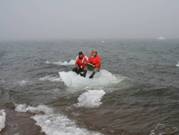Arctic Collaboration in the U.S. Army Corps of Engineers-Alaska District
 The Alaska District is tackling mounting concerns associated with climate change. The civil works program is incorporating the latest science and engineering into potential water resource development projects. These projects consist of navigation, flood control and ecosystem restoration business lines.
The Alaska District is tackling mounting concerns associated with climate change. The civil works program is incorporating the latest science and engineering into potential water resource development projects. These projects consist of navigation, flood control and ecosystem restoration business lines.
Hubbard Glacier near Yakutat
 Glaciologists believe that the Hubbard Glacier is shifting as a result of climate change. As a result, the existing watershed surrounding the Yakutat could experience large-scale changes ultimately impacting the local fishery-based economy. The Alaska District initiated a study to better understand how some of the changes would likely occur within this watershed.
Glaciologists believe that the Hubbard Glacier is shifting as a result of climate change. As a result, the existing watershed surrounding the Yakutat could experience large-scale changes ultimately impacting the local fishery-based economy. The Alaska District initiated a study to better understand how some of the changes would likely occur within this watershed.
Black Lake
The  Alaska District has taken on a 206 Aquatic Ecosystem Restoration Study in coordination the Chignik Regional Aquaculture Association, and Alaska Department of Fish and Game to attempt to determine the resiliency of the local salmon stocks to a shallowing Black Lake system. It has been postulated that while the shallowing of these lakes is a natural process, the process may be happening quicker than anticipated with a changing climate. As a result, studies are under way to determine how robust the local salmon stocks are, and how these changes will impact the fishery and ultimately the local fishery-based economy.
Alaska District has taken on a 206 Aquatic Ecosystem Restoration Study in coordination the Chignik Regional Aquaculture Association, and Alaska Department of Fish and Game to attempt to determine the resiliency of the local salmon stocks to a shallowing Black Lake system. It has been postulated that while the shallowing of these lakes is a natural process, the process may be happening quicker than anticipated with a changing climate. As a result, studies are under way to determine how robust the local salmon stocks are, and how these changes will impact the fishery and ultimately the local fishery-based economy.
Chena Project in North Pole
 Shifting climates means shifting weather patterns. The Alaska District stands ready to assist with flood risk mitigation in the Chena watershed near Fairbanks. As a part of this ongoing effort, various types of climate data are recorded for analyses. River stages and snowmelt data are a couple of examples of the data collected. Long-term records of this type will allow engineers and scientists to track changing conditions as they occur and thus react accordingly.
Shifting climates means shifting weather patterns. The Alaska District stands ready to assist with flood risk mitigation in the Chena watershed near Fairbanks. As a part of this ongoing effort, various types of climate data are recorded for analyses. River stages and snowmelt data are a couple of examples of the data collected. Long-term records of this type will allow engineers and scientists to track changing conditions as they occur and thus react accordingly.
Little Diomede Navigation Study
 Preliminary investigations are under way at Little Diomede in northwest Alaska to determine if there is potential for safe harbor or any other navigation project. Given the geographic location of Little Diomede, with a rapidly changing Arctic, Little Diomede may be in a strategic location to provide services for increased vessel traffic using Arctic shipping lanes.
Preliminary investigations are under way at Little Diomede in northwest Alaska to determine if there is potential for safe harbor or any other navigation project. Given the geographic location of Little Diomede, with a rapidly changing Arctic, Little Diomede may be in a strategic location to provide services for increased vessel traffic using Arctic shipping lanes.